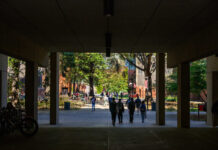Their ghost hunt wasn’t part of a club initiation; it was a philosophy class assignment designed to test their critical thinking skills.
It might seem like a stretch to connect prowling around Waverly Hills Sanatorium, an old tuberculosis hospital reported to be haunted, with critical thinking, but it really isn’t, said philosophy professor Brian Barnes. In fact, this is the third time he has had his critical thinking class complete the exercise.
Barnes charged his students to use the Paul-Elder framework as the basis for their investigation. Students visited sites and filmed what they saw. They tried to make calls as to whether the claims of hauntings were good or poor and to explain the reasoning behind their findings.
“In critical thinking class, we learn critical thinking skills and explore different methods of thinking critically about ourselves and the world around us,” Barnes said. “We’ve been discussing the paranormal — ghosts, what happens to you after you die, etc.
“Critical thinking shouldn’t really be just for philosophy. It’s for everything,” Barnes said. “By also bringing in digital media, it builds up a skill set the students may not have had. It builds a wider connection to everything.”
Other UofL students, faculty and staff can see the films Barnes’ students and students in other classes made at “Lights, Camera, Ideas 2 Action,” a daylong digital project showcase April 20 at the Rauch Planetarium.
Now in its second year, “Lights, Camera, Ideas 2 Action,” highlights the collaboration between the i2a program and the Digital Media Suite, said Nisha Gupta, specialist for culminating undergraduate experiences with the Delphi Center for Teaching and Learning.
This year’s participating classes come from philosophy, psychology, social work, health and sports sciences, math, English and theater.
Faculty members whose classes participated received one-on-one assignment design support to help incorporate i2a concepts into their digital assignments. Students received technical support and access to professional grade equipment to develop and produce their digital projects.
Using video and other digital platforms allows students to think outside of the box and challenge themselves because some things can be done digitally that can’t be done through a poster session or paper, Gupta said.
“It really forces the students to do so much more in terms of synchronization,” she said. “It requires that students incorporate all of their skills sets to solve problems and explain solutions.”
Since the beginning of the semester, faculty and students have been working on the projects — identifying topics, filming and creating graphics if needed. Now that it’s crunch time, students have been spending extra time in the Digital Media Suite at Ekstrom Library to finalize their work.
Mallory Durham, a sophomore in Lee Gibson’s Math 301 class, was among the students there last week. She and her group were using a software program to design three-dimensional graphics to better explain the static force in a game of billiards.
The project not only required the use of math skills, but also required learning the new software and videotaping a pool game to illustrate how their equations worked.
“This has been a really challenging assignment,” she said. “I’ve learned so much more from this project than others.”
Phillip Brown, another student in Gibson’s class, worked with his group on a project that used three-dimensional graphics to illustrate Van der Waals’ equation, which shows changes between liquid and gas phases of substances.
“It’s a tough thing to illustrate,” Brown said. “We still have a way to go.”
Participating Classes
Philosophy 211: Critical Thinking
Psychology 582: Intro to Clinical Psychology
Social Work 322: Issues in Policy & Service Delivery
Health & Sports Sciences 531: Leadership in Health Promotion
Math 301: Calculus III, Multivariable Calculus
Social Work 322: Issues in Policy & Service Delivery
Psychology 201: Honors Intro to Psychology
English 504: Advanced Creative Fiction


























